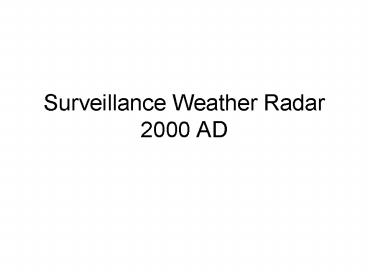Surveillance Weather Radar 2000 AD PowerPoint PPT Presentation
1 / 21
Title: Surveillance Weather Radar 2000 AD
1
Surveillance Weather Radar 2000 AD
2
Weather Radar Technology- Merits in
Chronological Order
3
Technology Developments
- Digital receivers
- Easy to achieve sampling rate higher than
reciprocal of pulse (oversampling) - Versatile circuits for transmitter control
- Easy to phase code, to interleave PRTs (staggered
and other), to compress pulse - Signal processing on general purpose computers
(PCs) - Easy to program algorithms and analyze Doppler
spectra
4
Capability of the NSSLs RD weather surveillance
radar
- Doppler and Dual Polarization
- Phase coding of transmitted pulses
- Transmission of arbitrary non uniform pulse
sequence including staggered PRT - Oversampling
- by a factor of 5 in Dual Polarization Mode
- By a factor of 10 in Single Polarization Mode
- Arbitrary scanning strategy (including RHI)
- Recording of time series data
5
Oversampling
- To increase speed of volume coverage
- To decrease errors in estimates of reflectivity,
velocity, spectrum width, and polarimetric
variables
6
Z, Standard Processing, Aug 04
7
Z, from Decorrelated Samples
8
Mitigation of range velocity ambiguities
- Phase coding at lower elevations
- Staggered PRT at higher elevations
- Demonstration of clutter filtering for both
schemes - Integration into volume coverage patterns
- Inclusion of oversampling
- Adaptive automatic choice of PRTs based on
obscurations in immediately preceding scans
9
Phase Coding
10/08/02 1511 GMT
EL 0.5 deg
ReflectivityLong PRT
10
Phase Coding
11
Staggered PRT
04/06/03 442 GMT
EL 2.5 deg
ReflectivityStaggered PRT
12
Staggered PRT
04/06/03 442 GMT
KTLX Doppler VelocityVCP 11 Batch Mode
KOUN Doppler Velocity Staggered PRT (184 km/276
km)
EL 2.5 deg
13
Dual Polarization at NSSL
- 1983 Upgrade of Cimarron radar to dual
polarization switching between horizontal and
vertical polarization - 1984 Collection of first (anywhere) dual
polarization time series data - 1985 to 1989 Definition of the complete set of
polarimetric variables. Development of schemes to
obtain these variables together with spectral
moments - 1992 First (anywhere) collection of polarimetric
variables at all range locations - 1992 to present Development of schemes to
classify hydrometeor type. Improvement of
rainfall estimation. Design of a system
functionally compatible with the WSR-88D
simultaneous transmission and reception of
horizontally and vertically polarized waves - 2002 Upgrade of KOUN radar to dual polarization
- 2002-2003 Joint POLarization Experiment (JPOLE)
14
Fields of polarimetric variables
15
Dual Polarization - Benefits
- Vastly superior data quality calibration,
mitigation of attenuation and beam blockage
effects - Discrimination between insects, birds, ground
echoes, and precipitation - Superior measurement of rainfall
- Detection of hail
- Classification of precipitation rain vs
freezing rain vs snow - Determination of hail size
- Measurement of snowfall
- Icing detection
16
Stratiform Rain vs Snow
17
Imminent Goals
- Combining techniques to mitigate range and
velocity ambiguities with optimum (pseudo
whitening) procedure to increase speed of volume
coverage and decrease errors of estimates - Incorporating the above combined technique into
dual polarization radar - Developing adaptive scanning strategy for agile
beam phased array radar
18
Three Challenges
- Direct estimation of wind transverse to the radar
beam - Determination of the alias interval of Doppler
velocity from a single pulse - Estimation of the forward propagation coefficient
using returns from hydrometeors or biological
scatterers
19
Major Endeavor
- Explaining bulk hydrometeor properties that cause
distinct polarimetric signatures in convective
storms
20
Major Endeavor
- Assimilation of radar data into local NWP (short
term 3 h, fine resolution 1 km) model - coupled to distributed hydrological model for use
over small watersheds ( 1000s km2) - capable of predicting tornadoes, strong winds,
hail, and other hazards
21
END
- These are the news from the Prairie Town of
Norman - Were all meteorologists are No 1
- And Engineers are second to none

